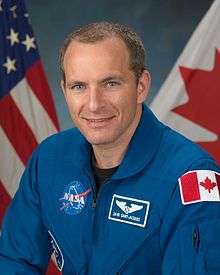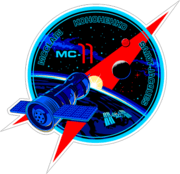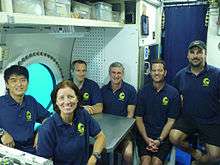David Saint-Jacques
David Saint-Jacques (in Quebec: [davɪd sẽɪ̯̃nʒã(ŋ)k̚], French pronunciation: [david sɛ̃ʒak]; born January 6, 1970)[2] is a Canadian astronaut with the Canadian Space Agency (CSA). He is also an astrophysicist, engineer, and a physician.
David Saint-Jacques | |
|---|---|
 | |
| Born | January 6, 1970 Quebec City, Quebec, Canada |
| Status | Active |
| Nationality | Canadian |
| Alma mater | University of Cambridge Université de Montréal Université Laval |
| Occupation | Astrophysicist/Physician |
| Space career | |
| CSA Astronaut | |
Time in space | 203 days 15 hours 16 minutes[1] |
| Selection | 2009 CSA Group |
Total EVAs | 1 |
| Missions | Soyuz MS-11 (Expedition 58/59) |
Mission insignia |  |
In December 2018 he launched to the International Space Station, as Flight Engineer on Expeditions 57, 58 and 59; he returned to Earth on June 25, 2019.
Astronaut career

Saint-Jacques was selected in May 2009 by the Canadian Space Agency (CSA) as one of two CSA astronaut positions, after a long process selection attended by 5,351 candidates, and has moved to Houston to be one of 14 members of the 20th NASA astronaut class.[3][4] He recently graduated from Astronaut Candidate Training that included scientific and technical briefings, intensive instruction in International Space Station systems, extravehicular activity (EVA), robotics, physiological training, T-38 flight training, Russian language and water and wilderness survival training. Since graduation, he has been assigned to the Robotics Branch of the Astronaut Office.[3]
NEEMO 15
On September 19, 2011, NASA announced that Saint-Jacques would serve as an aquanaut aboard the Aquarius underwater laboratory during the NEEMO 15 undersea exploration mission from October 17–30, 2011.[5] Delayed by stormy weather and high seas, the mission began on October 20, 2011.[6][7] On the afternoon of October 21, Saint-Jacques and his crewmates officially became aquanauts, having spent over 24 hours underwater. NEEMO 15 ended early on October 26 due to the approach of Hurricane Rina.[6]
Expeditions 57/58/59

_David_Saint-Jacques.jpg)
In May 2016 Saint-Jacques was selected as a member of ISS Expedition 58/59, which at the time was scheduled to start in November 2018.[8]
On 3 December 2018, Saint-Jacques launched to the ISS on board Soyuz MS-11, alongside commander Oleg Kononenko and fellow flight engineer Anne McClain.[9] He became a member of the Expedition 57 crew for two weeks before transferring to Expedition 58, which officially started on 20 December 2018 when the Expedition 57 crew left the station. Saint-Jacques, Kononenko and McClain subsequently transferred to Expedition 59 on 14 March 2019 with the arrival of Soyuz MS-12.
On April 8, 2019, Saint-Jacques conducted his first spacewalk,[10] becoming the fourth Canadian astronaut to take part in an EVA and the first to do so in 12 years. The spacewalk lasted roughly seven hours.[11]
Saint-Jacques, McClain and Kononenko returned to earth on board Soyuz MS-11 on June 24, 2019.[1]
Education and earlier career
Saint-Jacques holds a BEng in Engineering Physics from the École polytechnique de Montréal, an affiliated college of Université de Montréal, where he graduated in 1993.[2] He later graduated in 1998 with a PhD in astrophysics,[12] from the Cavendish Astrophysics Group at the University of Cambridge. Saint-Jacques completed postdoctoral research at the National Astronomical Observatory of Japan between 1999–2001 where he worked on the development and application of the Mitaka Infrared Interferometer in Japan and the Subaru Telescope Adaptive Optics System in Hawaii.[3][4][13] He also holds a Doctor of Medicine from Université Laval completed in 2005 and completed a Family medicine residency at McGill University (2007) (specializing in first-line, isolated medical practice).[2]
His broad scientific background includes engineering, astrophysics and medical training, with international experience in France and Hungary for engineering study and Lebanon and Guatemala for medical study.[3] Saint-Jacques is affiliated with the Collège des médecins du Québec, College of Family Physicians of Canada, Ordre des ingénieurs du Québec, International Society for Optical Engineering, and the Cambridge Philosophical Society as a Life Fellow.[3] Saint-Jacques began his career in 1996 as a biomedical engineer at the Quebec firm Electromed with secondment to Lariboisière Hospital, working on the design of radiological equipment for angiography and image analysis algorithms of cineangiography.[3][4]
During 1994–98, his studies included theoretical work on astronomical observation and design, fabrication and commissioning of instruments for the Cambridge Optical Aperture Synthesis Telescope and for the William Herschel Telescope in the Canary Islands.[3] During the course of this research under supervisor John E. Baldwin he made several trips abroad on sponsorship from the Particle Physics and Astronomy Research Council, the Cavendish Astrophysics Group, Corpus Christi College and the Cambridge Philosophical Society, and decided to pursue further research experience in Japan.[12] In 2001, he joined the Astrophysics group at the Department de physique, Université de Montréal.[3][14]
Prior to joining the Canadian Space Program, Saint-Jacques was a medical doctor and the Co-chief of Medicine at Inuulitsivik Health Centre in Puvirnituq, Quebec since 2007. He also worked as a Clinical Faculty Lecturer for McGill University's Faculty of Medicine, supervising medical trainees in Nunavik.[2]
Personal life
Saint-Jacques was born in Quebec City and raised in the Montreal suburb of Saint-Lambert, Quebec. Saint-Jacques is married to Dr. Véronique Morin and has three children.[15] He is a lifelong mountaineer, hiker, cyclist, skier, and sailor.[2][3] He also holds a commercial pilot license.[3] He is fluent in French and English, and has a basic understanding of Russian, Spanish and Japanese.[2][3][16]
Academic distinctions
- "1967" Science and Engineering Scholarship, Natural Sciences and Engineering Research Council of Canada (NSERC) (1994–1998)
- Cambridge Commonwealth Trust Honorary Scholar (1994–1998)
- United Kingdom Overseas Research Student Award (1994–1998)
- Postdoctoral Fellowship, Japan Society for Promotion of Science (1999–2001)
- Scholarship, Canada Millennium (2001–2005)
- Doctorat Honoris Causa, École polytechnique de Montréal of Université de Montréal (2010)[4]
Honors and awards
- Fellow of the Royal Canadian Geographical Society
- Gold Medal of the Royal Canadian Geographical Society
References
![]()
![]()
- Harwood, William (June 25, 2019). "3 station fliers complete "once-in-a-lifetime ride" home after 204-day stay in orbit". CBS News.
- National Aeronautics and Space Administration (September 15, 2011). "NASA – Meet the NEEMO 15 Crew". NASA. Retrieved September 19, 2011.
- "Astronaut Candidate Bio: David Saint-Jacques (10/2011)". NASA. Retrieved 2012-02-12.
- "DOCTORAT HONORIS CAUSA" (PDF). École Polytechnique de Montréal. 2010. Retrieved 2012-02-12.
- NASA (September 19, 2011). "NASA – NASA Announces 15th Undersea Exploration Mission Date And Crew". NASA. Retrieved September 19, 2011.
- NASA (October 27, 2011). "NASA – NEEMO 15 Topside Reports". NASA. Retrieved 2019-04-01.
- Walker, Shannon (October 21, 2011). "NEEMO 15 – Splashdown Day!". NASA. Retrieved 2019-04-01.
- http://asc-csa.gc.ca/eng/missions/expedition58-59/default.asp
- Gebhardt, Chris. "100th orbital launch of 2018: International trio set for launch to Space Station – NASASpaceFlight.com". NASASpaceflight.com. Retrieved 3 December 2018.
- Harding, Pete; Bergin, Chris. "Following ISS battery upgrade, EVA-54 works on power systems". NASASpaceFlight.com.
- "Astronaut David Saint-Jacques first Canadian to perform spacewalk in 12 years". The Hamilton Spectator. 8 April 2019.
- David Saint-Jacques (December 1998). "Atmospheric Seeing in Space and Time: a study of atmospheric turbulence in Spain and England, 1994-98". University of Cambridge. Archived from the original on 2009-05-18. Retrieved 2009-05-16.; View as HTML.
- David Saint-Jacques; et al. (2002-12-25). "Near-Infrared Coronagraphy of the GG Tauri A Binary System" (PDF). PASJ. Archived from the original (PDF) on 2007-04-17. Retrieved 2012-02-12.
- David Saint-Jacques; et al. (2004-02-25). "Performance of Subaru Cassegrain Adaptive Optics System" (PDF). PASJ. Archived from the original (PDF) on 2008-02-21. Retrieved 2012-02-12.
- "David Saint-Jacques". Canadian Space Agency. 2009-05-14. Retrieved 2009-05-14.
External links
| Wikimedia Commons has media related to David Saint-Jacques. |